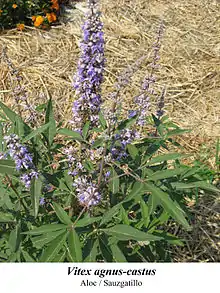بنجنكشت
Arabic

بَنْجَنْكُشْت
Alternative forms
- فَنْجَنْكُشْت (fanjankušt)
Etymology
Borrowed from Persian پنجانگشت (panj-angošt, “chaste tree”, literally “five-finger”), so named because of the leaves ordered in groups of five. So this plant in Ancient Greek πεντάφυλλον (pentáphullon) and in Arabic ذُو خَمْسَة أَصَابِع (ḏū ḵamsa(t) ʔaṣābiʕ).
Pronunciation
- IPA(key): /ban.d͡ʒan.kuʃt/
Noun
بَنْجَنْكُشْت • (banjankušt) m
- chaste tree (Vitex agnus-castus)
- Synonyms: حَبّ الْفَقْد (ḥabb al-faqd), سَرْسَاد (sarsād), ذُو خَمْسَة أَصَابِع (ḏū ḵamsa(t) ʔaṣābiʕ)
- c. 1200, يحيى بن محمد بن أحمد بن العوام [Yaḥyā ibn muḥammad ibn ʾaḥmad ibn al-ʿawwām], José Antonio Banqueri, editor, كتاب الفلاحة [Book on Agriculture], volume 2, Madrid: Imprenta Real, published 1802IA, Cap. 29, Art. 12, page 365:
Declension
Declension of noun بَنْجَنْكُشْت (banjankušt)
| Singular | basic singular triptote | ||
|---|---|---|---|
| Indefinite | Definite | Construct | |
| Informal | بَنْجَنْكُشْت banjankušt |
الْبَنْجَنْكُشْت al-banjankušt |
بَنْجَنْكُشْت banjankušt |
| Nominative | بَنْجَنْكُشْتٌ banjankuštun |
الْبَنْجَنْكُشْتُ al-banjankuštu |
بَنْجَنْكُشْتُ banjankuštu |
| Accusative | بَنْجَنْكُشْتًا banjankuštan |
الْبَنْجَنْكُشْتَ al-banjankušta |
بَنْجَنْكُشْتَ banjankušta |
| Genitive | بَنْجَنْكُشْتٍ banjankuštin |
الْبَنْجَنْكُشْتِ al-banjankušti |
بَنْجَنْكُشْتِ banjankušti |
References
- Dozy, Reinhart Pieter Anne (1881), “بنجنكشت”, in Supplément aux dictionnaires arabes (in French), volume 1, Leiden: E. J. Brill, page 117
- Dozy, Reinhart Pieter Anne (1881), “بنجنكشت”, in Supplément aux dictionnaires arabes (in French), volume 2, Leiden: E. J. Brill, page 283
- Löw, Immanuel (1924) Die Flora der Juden (in German), volume 3, Wien und Leipzig: R. Löwit, pages 491–494
- Löw, Immanuel (1881) Aramæische Pflanzennamen (in German), Leipzig: Wilhelm Engelmann, pages 375–376
This article is issued from Wiktionary. The text is licensed under Creative Commons - Attribution - Sharealike. Additional terms may apply for the media files.